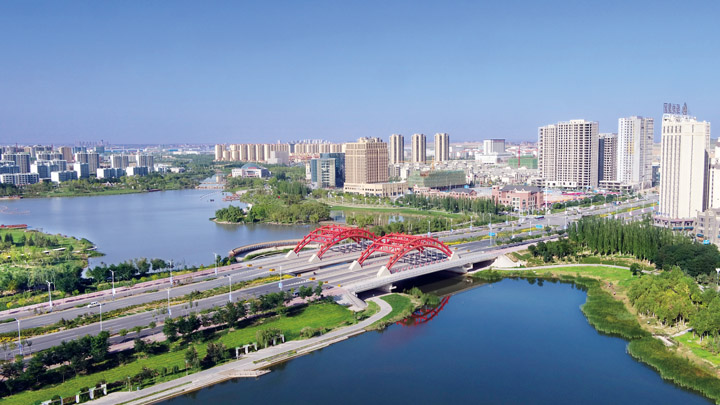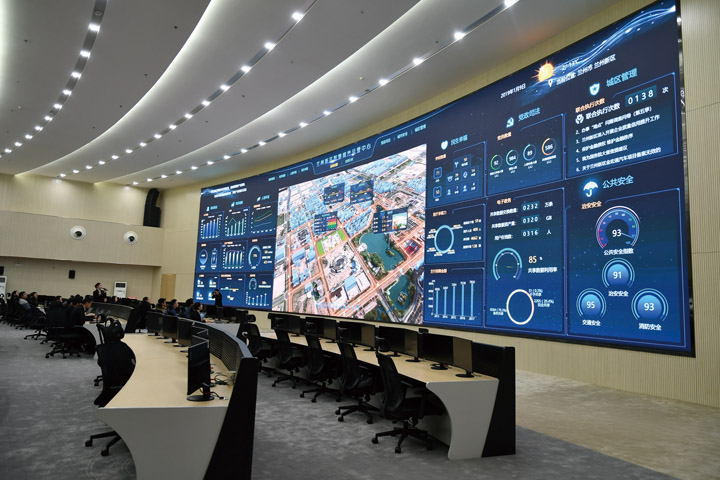LNA: Building a Smart National New Area with Science, Technology, and Intelligence
Enterprise products, solutions & services

As northwestern China’s first national New Area, the Lanzhou New Area (LNA) plays a critical role in the region’s development: It is positioned as an important economic growth pole, a national industrial base, and a strategic platform to facilitate opening up in western China; it also serves as a demonstration area for industrial relocations. Based on President Xi Jinping’s major speeches on national big data strategy and digital China, the LNA is perfectly aligned with the country’s strategic position, as it “promotes innovations with science and technology, and seeks development with intelligence.” With the principle of “good governance that benefits the people and promotes industries” at its core, a new Smart City is being built at the LNA.
Close cooperation between the LNA and Huawei began in 2017. Together they planned and formulated top-level design schemes for the Smart City, with 22 projects covering ICT infrastructure platforms, city governance, public services, industry development, and Smart City operations. These projects facilitate the building of a digital economy centered around the Smart City, and replace traditional development drivers with new ones, boosting the area’s development.
Huawei Horizon Digital Platform lays a solid foundation for the area’s intelligent development. With Huawei Horizon Digital Platform, the LNA can take advantage of a multitude of advanced capabilities, such as cloud computing, big data, Internet of Things (IoT), Geographic Information System (GIS), video convergence, and communications integration. Based on these capabilities, the platform uniformly carries information systems of over 40 departments, connects to eGovernment extranets of more than 30 departments, and covers 45 eLTE wireless base stations across the city.
Nine service projects have been launched in the first phase: the Smart City operation center (the city’s brain), government big data sharing and exchange platform, spatio-temporal information service platform, IoT platform, eLTE municipal wireless private network, eGovernment extranet, government collaborative office platform, government service linkage approval system, and smart healthcare. Second phase projects — such as the emergency command linkage system, grid city management platform, and video cloud — are now under construction.
The benefits of the new Smart City are evident: bringing better governance and quality of life to residents as well as optimizing the use of urban resources. The goals to use scientific decision-making, provide efficient public services, and practice optimal social governance have been achieved, with all-round intelligence empowering the area’s development.
• Smart Brain Enables Visualized City Governance and Intelligent Decision-Making
The Smart City’s Intelligent Operation Center (IOC) is built on the principles of “unified planning, centralized sharing, and coordinated services,” creating a unified system architecture with unified standards, specifications, construction and Operations and Maintenance (O&M). The construction period lasted for more than a year, and it covers three decision-making analyses (economic, industrial and urban public safety analysis), and two applications (emergency command linkage and grid-based management) that concern seven situational topics, such as people’s livelihoods, the economy, city governance, and urban safety.
The Smart City IOC, powered by Huawei Horizon Digital Platform’s Artificial Intelligence (AI) and big data architecture, aggregates the area’s panoramic data, and can perform data analysis and intelligent modeling for key operational indexes. It also features city situational awareness, operation management, monitoring, and decision-making support. With visualization for city information, the IOC enables event management and emergency command, and the coordination of different departments for unified linkage and command, improving emergency-handling efficiency by 50 percent.
• Smart Government Improves Administrative Service Efficiency
The LNA is promoting administrative services that are “commitment-based, free, informative, and agent-based” to shorten the project approval and implementation time from 60 to 10 working days, and process 594 administrative approval items under the “One Number, One Window, One Network” principle to improve service efficiency by 100 percent. Newly established community service centers and 24-hour self-service kiosks make government services more readily available, improving service efficiency by 50 percent. A new electronic certificate database has also been established to integrate business license, organization code, tax registration, social insurance, and statistical registration — improving enterprise service efficiency by 100 percent. The LNA greatly improves comprehensive tax collection and management of national taxes and land taxes by enabling taxpayers to issue electronic invoices on cellphones, reducing costs for enterprises by 30 percent. Additionally, because tax services are simplified and more convenient, tax offices are less crowded and can operate with fewer disruptions.
The LNA also has an exceptional business environment. For example, its agent-based service provides enterprises with full-process services free of charge. The free service reduces early project costs by 70 percent. The incremental power distribution reform reduces the electricity price for each household of big data enterprises to only CNY 0.28 per kilowatt hour (about US$0.4/kWh), leading to electricity cost savings of more than 60 percent. The trial implementation of a flexible land transfer policy reduces land costs by offering more options, such as leasing and transfer before leasing. The LNA has also adopted a series of favorable and supportive policies, and has delivered financial incentives totaling CNY 4.2 billion (about US$814 million). With all of these measures contributing to make the LNA business-friendly, it has attracted more than 600 enterprises to operate here since its inception.
• Grid-Based Governance Refines City Governance
A comprehensive city governance platform is built based on grids; it uses geographic information technologies to integrate various information from urban events and IoT components to build a “grid-based governance map.” The LNA has constructed a total of 770 grids, covering Zhongchuan Park, Qinchuan Park, and Xicha Park. Grids are divided into four levels: areas, streets, communities and grids — covering the entire LNA. The area provides clear and specific case standards for 114 categories of major and minor events and IoT components, including 13 major event categories, such as the urban environment, public safety, food and drug safety, and campus safety. Relevant departments are incorporated into the grid-based platform based on the event categories, to facilitate accurate and efficient communication and improve processing efficiency.
• Smart Emergency Response Improves City Emergency Governance
The newly built emergency command system enables the integration, optimization, and sharing of public safety data, and improves governance for emergency response. The command communications system integrates multiple networks to obtain a range of capabilities such as comprehensive communication convergence, full-process data aggregation, all-domain video perception, and all-dimensional presentation. Additionally, public safety awareness is heightened and intelligent emergency management is realized. Such an emergency management system enables unified command, the combination of ordinary and specialized systems, quick responses, upper and lower level linkages, and combined emergency prevention and emergency response operations. Disaster prevention, mitigation, and relief are also improved, ensuring social stability, and providing greater safety for both lives and property in the area.
• Unified Platform Unlocks Value
China’s first city-level government networks were built in the LNA, integrating wired optical communications, wireless command, and IoT sensor networks. Broadband and narrowband services are integrated, and 34 government extranet units and 45 eLTE wireless base stations are connected to create a centralized and unified government high-speed backbone network, covering the entire district. This network allows physical multiplexing of various fields and services, such as public safety, finance, energy, transportation, healthcare, and education. It ensures that network resource intensification (the integration of resources for improved efficiency) in the LNA is improved by eight times, effectively prevents network splitting and repeated construction, and delivers excellent value for money.
• Smart Healthcare Balances Medical Resources
Three healthcare institutes and 61 healthcare service center systems were developed based on smart healthcare, serving about 70 percent of the population in the area. In just two years, healthcare has gone through a monumental change: all-domain medical and healthcare information data sharing are realized, and health services — such as diagnosis, treatment, query, registration, complaint, and performance appraisal — can be done online. Residents of the area are offered unified E-Health cards and E-Health Records (EHR), which are used to share information between medical institutions. Physiological data sensors have been installed in more than 100 community medical institutions to implement comprehensive remote healthcare and assist with emergency medical rescue. The LNA is reinventing healthcare by delegating minor disease treatment and recovery to community practices and major disease treatment to hospitals.
• Intelligence Enables Industry Upgrade
A 3.33-square-kilometer cloud computing industrial park and 1-square-kilometer Silk Road information port was constructed in the LNA’s core area. Thirty-five big data projects were signed, including HUAWEI CLOUD computing, Tsingchuang cloud computing, and State Grid cloud data center, with a total investment of CNY 35.3 billion (about US$5 billion). By the end of 2019, 25,000 racks will be installed to provide services for 250,000 cloud computing terminals. The LNA estimates that more than 100,000 racks will be installed by 2020, to provide high-quality, efficient, safe, and reliable big data services for 1 million cloud computing terminals in northwestern China as well as countries along the Belt and Road route.

Seizing the major opportunities created by China’s development and the proliferation of big data technology, the LNA drives innovation through science and technology and seeks intelligence-based development. Intelligence is at the center of the Smart City, empowering the city’s comprehensive governance, public services, and economic development. Intelligence is also the key to transforming the city into a ‘Silk Road Information Port City,’ and an ‘Intelligent Manufacturing Base.’
In the process of building a new Smart City, the LNA has proven to be a pioneer, with new highlights, features, and achievements being widely recognized and praised by the industry. The area has received multiple awards over the years — including: 2017 China Smart City Innovation Award, 2018 China Smart City Innovation Award, and 2018 Top 10 Recommended Smart City Visiting Destination Award — and has debuted as an exemplar city at The Fourth China Smart City International Expo.
We are striving to make the LNA into a model city and elevate the standard for Smart City construction for other New Areas in China.